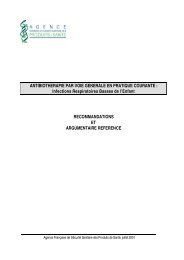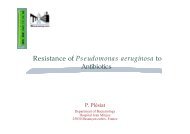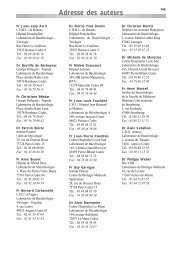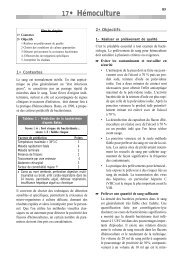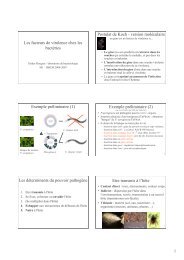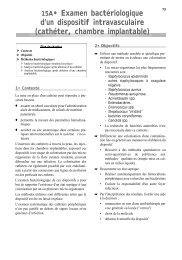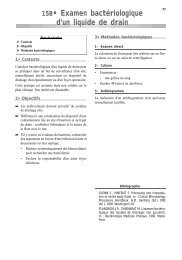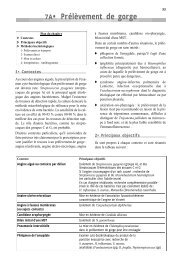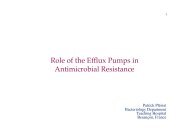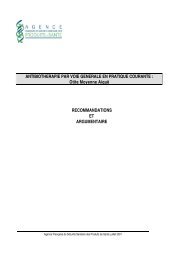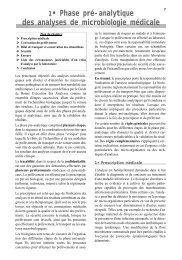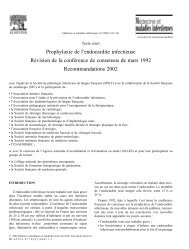E. coli - BACTERIOWEB
E. coli - BACTERIOWEB
E. coli - BACTERIOWEB
Create successful ePaper yourself
Turn your PDF publications into a flip-book with our unique Google optimized e-Paper software.
Role of the Efflux Pumps in<br />
Antimicrobial Resistance in E. <strong>coli</strong><br />
Patrick Plésiat<br />
Bacteriology Department<br />
Teaching Hospital<br />
Besançon, France
ANTIBIOTIC<br />
TARGET
Cell wall<br />
Bacterial targets for antibiotics<br />
Chromosome<br />
Cytoplasmic membrane<br />
Ribosomes
Main resistance mechanisms to drugs<br />
Inactivation<br />
Modification<br />
Protection<br />
ANTIBIOTIC<br />
TARGET<br />
Substitution<br />
Amplification<br />
Efflux<br />
Impermeability<br />
Reduced affinity<br />
- mutations<br />
- recombinaisons<br />
- enzymatic modification
Gram-negative species with known efflux systems<br />
♦Escherichia <strong>coli</strong><br />
♦Salmonella Typhimurium<br />
♦Shigella dysenteriae<br />
♦Klebsiella pneumoniae<br />
♦Enterobacter aerogenes<br />
♦Serratia marcescens<br />
♦Proteus vulgaris<br />
♦Citrobacter freundii...<br />
♦Bacteroides fragilis...<br />
♦Pseudomonas aeruginosa<br />
♦Pseudomonas putida<br />
♦Burkholderia cepacia<br />
♦Burkholderia pseudomallei<br />
♦Stenotrophomonas maltophilia<br />
♦Alcaligenes eutrophus...<br />
♦Haemophilus influenzae<br />
♦Campylobacter jejuni<br />
♦Helicobacter pylori<br />
♦Vibrio parahaemolyticus<br />
♦Vibrio cholerae<br />
♦Neisseria gonorrhoeae...
Efflux mechanisms: practical implications<br />
Do efflux systems produce clinically relevant levels of<br />
resistance ?<br />
Does the expression of drug transporters somewhat impair the<br />
virulence of bacterial pathogens ?<br />
What is the prevalence of efflux systems relative to other<br />
resistance mechanisms among the clinical isolates ?<br />
How to recognize efflux mutants in laboratory practice ?<br />
What recommendations can be made to the physician for the<br />
treatment of patients infected with mdr strains ?
Intracellular accumulation<br />
Drug accumulation experiments<br />
S<br />
R<br />
CCCP<br />
Time<br />
ATP<br />
glucose
Structure of bacterial efflux systems<br />
One component systems<br />
– Mostly in Gram positive species (except Tet...)<br />
– A single transporter protein in the cytoplasmic membrane<br />
– Determines the substrate specificity and resistance<br />
Three component (tripartite) systems<br />
– Exclusively in Gram negative species (GNB)<br />
♦ A transporter protein<br />
♦ A periplasmic adaptor lipoprotein<br />
♦ A outer membrane channel protein
Antiporters<br />
Energy sources<br />
– PMF transporters (proton motive force)<br />
– Na + -antibiotic antiporters<br />
ABC transporters<br />
– ATP binding cassette pumps<br />
– Hydrolysis of ATP into ADP + Pi<br />
– Mostly in Gram positive species
PMF transporters<br />
Major Facilitator Superfamily (MFS)<br />
– Drug efflux<br />
♦ 12 TMS transporters<br />
♦ 14 TMS transporters<br />
– Active uptake/export<br />
♦ sugars...<br />
♦ amino acids, secondary metabolites...<br />
Small Multidrug Resistance Family (SMR)<br />
♦ 4 TMS transporters<br />
Resistance/Nodulation Cell Division Family (RND)<br />
♦ 12 TMS transporters<br />
Multi Antimicrobial Extrusion Family (MATE)<br />
♦ 12 TMS transporters
H +<br />
Structure of drug efflux systems<br />
Na +<br />
antibiotic<br />
ATP ADP<br />
MFS, SMR MATE ABC RND, MFS, ABC<br />
H +<br />
antibiotic
Efflux systems in E. <strong>coli</strong><br />
Chromosomally encoded pumps<br />
– 37 putative drug transporters: 19 MFS, 3 SMR, 7 RND, 7 ABC, 1<br />
MATE<br />
– 20 pumps are able to transport toxic/antibiotic molecules<br />
– 15-17 pumps may provide with some resistance to antibiotics when<br />
overproduced from plasmid genes (Nishino K et al. J. Bacteriol. 2001)<br />
– Upregulation of a single pump results in increased drug efflux<br />
Acquisition of exogenous pump encoding genes<br />
– Genes carried by mobile elements (plasmids, transposons,<br />
integrons)
Efflux pumps coded by mobile genetic elements<br />
Species System Family Substrates<br />
E. <strong>coli</strong> TetA/B/E MFS Tc, Min<br />
E. <strong>coli</strong> CmlA MFS Cmp<br />
E. <strong>coli</strong> Flo MFS Cmp, Flo<br />
E. <strong>coli</strong> OqxAB RND Olaquindox<br />
Tc: tetracycline; Min: minocycline; Cmp: chloramphenicol; Flo: florfenicol
Efflux pumps of MFS, MATE, SMR, or ABC family<br />
Species System Family Substrates Genes<br />
E. <strong>coli</strong> EmrAB-TolC MFS Nal C<br />
E. <strong>coli</strong> Bcr MFS Tc, Km, Fos C<br />
E. <strong>coli</strong> MdfA MFS Tc, Rif, Cmp, Ery, Neo, Fq... C<br />
E. <strong>coli</strong> MdtG MFS Fos C<br />
E. <strong>coli</strong> MdtH MFS Fq C<br />
E. <strong>coli</strong> MdtL MFS Cmp C<br />
E. <strong>coli</strong> MdtM MFS Cmp, Fq C<br />
E. <strong>coli</strong> NorE MATE Cmp, Fq, Fos, Tmp C<br />
E. <strong>coli</strong> EmrE SMR Tc C<br />
E. <strong>coli</strong> MdtJK SMR Nal, Fos C<br />
E. <strong>coli</strong> MacAB-TolC ABC Ery C<br />
Nal: nalidixic acid; Tc: tetracycline; Km: kanamycin; Fos: fosfomycin; Rif: rifampicin; Cmp: chloramphenicol; Ery:<br />
erythromycin; Neo: neomycin; Fq: fluoroquinolones; Tmp: trimethoprim
Efflux pumps of the RND family<br />
Bacteria System Substrates<br />
E. <strong>coli</strong> AcrAB-TolC1 Fq, ß-lactams3 , Tc, Cmp, Nov, Ery, Fus, Rif…<br />
E. <strong>coli</strong> AcrEF-TolC2 Fq, ß-lactams3 , Tc, Cmp, Nov, Ery, Fus, Rif…<br />
E. <strong>coli</strong> AcrD2-AcrA-TolC AGs, Ery, PolyB<br />
E. <strong>coli</strong> CusAB-? 2 Fos<br />
E. <strong>coli</strong> MdtABC-TolC2 Fq<br />
E. <strong>coli</strong> MdtEF-TolC2 Ery<br />
P. aeruginosa MexAB-OprM1 Fq, ß-lactams1 , Tc, Cmp, Nov, Ery, Fus, Tm...<br />
P. aeruginosa MexCD-OprJ2 Fq, 3rd GC, Tc, Cmp, Ery, Tmp<br />
P. aeruginosa MexEF-OprN2 Fq, Cmp, Tmp<br />
P. aeruginosa MexXY2-OprM Fq, AGs, 3rdGC, Ery, Tc<br />
N. gonorrhoeae MtrCDE1 Tc, Cmp, ß-lactams1 , Ery, Fus, Rif...<br />
Fq: (fluoro)quinolones; Tc: tetracycline; Cmp: chloramphenicol; Nov: novobiocin; Ery: erythromycin; Fus: fusidic acid; Rif:<br />
rifampicin; AGs: aminoglycosides; PolyB: polymyxin B; Tmp: trimethoprim; Sulf: sulfamethoxazole; 3 rd GC: cefepime, cefpirome.<br />
1 expressed constitutively in wild type cells, 2 inducible expression, 3 except imipenem.
Induction of acrAB-tolC expression<br />
tetracycline<br />
chloramphenicol<br />
salicylate-acetylsalicylate<br />
benzoate<br />
stress...<br />
MarRAB<br />
∇ Porin OmpF<br />
∆ TolC<br />
∆ AcrAB<br />
∆ EmrAB<br />
∆∇Other proteins<br />
Mar regulon<br />
SoxSR oxidative stress<br />
Rob bile salts<br />
tetracycline r<br />
chloramphenicol r<br />
quinolones r<br />
erythromycin r<br />
solvants, pine oil...
Overexpression of acrAB and mtrCDE operons<br />
acrR<br />
mtrR<br />
-<br />
-<br />
+<br />
acrA<br />
+<br />
MarA<br />
acrB<br />
MtrA<br />
mtrC mtrD<br />
mtrE<br />
_ (MppA)<br />
MarR<br />
_<br />
SoxS SoxR<br />
mutations mdr
Systems MtrCDE and FarAB in N.<br />
gonorrhoeae<br />
Antibiotics wild type CDE ++ CDE - FarAB -<br />
Penicillin G 0.008 0.032 0.008 nd<br />
Erythromycin 0.25 1 - 2 0.06 0.25<br />
Tetracycline 0.25 0.5 nd nd<br />
Rifampicin 0.06 0.25 0.015 nd<br />
Linoleic acid 1600 nd 25 - 50 50<br />
Palmitic acid 100 nd 12.5 12.5
System AcrAB-TolC in E. <strong>coli</strong><br />
Antibiotics wild type AcrAB ++ AcrAB -<br />
Nalidixic acid 4 - 6 8.5 - 32 0.6<br />
Norfloxacin 0.025 - 0.1 0.3 - 1.25 nd<br />
Ofloxacin 0.06 - 0.07 0.25 - 0.3 nd<br />
Ciprofloxacin 0.02 0.15 nd<br />
Ampicillin 2 - 4 5 - 6 0.6 - 2<br />
Erythromycin 128 - 256 > 512 < 2 - 8<br />
Tetracycline 1.25 - 3 5 - 16 0.25 - 0.3<br />
Chloramphenicol 4 - 7.5 10 - 28 0.6
System MexAB-OprM in P. aeruginosa<br />
Antibiotics wild type MexAB ++ MexAB -<br />
Norfloxacin 0.25 - 1 2 - 4 0.05 - 0.25<br />
Ofloxacin 0.4 - 1 1.6 - 8 0.025 - 0.05<br />
Ciprofloxacin 0.03 - 0.25 0.4 - 1.6 0.012 - 0.03<br />
Carbenicillin 12.5 - 64 50 - 256 0.4 - 1<br />
Aztreonam 1.6 - 4 12.5 - 32 0.1 - 0.2<br />
Ceftazidime 0.4 - 2 1.6 - 8 0.2 - 0.4<br />
Cefepime 0.8 - 2 3 - 4 0.1 - 0.5<br />
Meropenem 0.2 - 0.5 0.8 - 2 0.1 - 0.2<br />
Tetracycline 6.25 - 16 25 -64 0.2 - 1.2<br />
Chloramphenicol 12.5 - 32 100 - 512 0.8 - 2
Interplays between resistance mechanisms in GNB<br />
Outer membrane<br />
permeability<br />
Active efflux<br />
Other mechanisms
Efflux/target double mutants of E. <strong>coli</strong><br />
Genotype/Phenotype Oflo Cipro<br />
wild type AG100 0.03 ≤0.015<br />
AcrAB ++ 0.125 0.06<br />
gyrA (Asp87->Gly) 0.25 0.25<br />
gyrA (Asp87->Gly; Ser83->Leu) 4 2<br />
gyrA (Asp87->Gly), AcrAB ++ 8 4<br />
gyrA (Asp87->Gly), AcrAB -<br />
0.06 0.03
Therapeutic implications of efflux systems<br />
Resistance levels conferred by intrinsic pumps<br />
– Low to moderate drug resistance (MIC x 2 - 16)<br />
– Clinical significance<br />
♦ Lack of clinical data !<br />
♦ Poor response to treatment when the concentrations of<br />
antibiotics are low at the infection site (insufficient dosage,<br />
inappropriate drug, abcess...)<br />
♦ Increased emergence of target mutants ?<br />
Emergence of gain of efflux mutants under treatment<br />
– Cross resistance to structurally unrelated molecules<br />
– Role of fluoroquinolones
Drug total daily dosage<br />
(mg)<br />
PK/PD Monte Carlo<br />
Treatment MIC (mg/L) Target Attainment Rate (%)<br />
unitary dose interval<br />
(hours)<br />
Cmax/MIC > 10 AUC/MIC > 125<br />
Ciproflox. 1200 8 0.12 66 87<br />
0.25 6 7<br />
1600 6 0.12 66 90<br />
0.25 5 12<br />
2400 8 0.12 98 100<br />
0.25 60 85<br />
0.5 4.2 3.7<br />
Levoflox. 500 24 0.5 70 40<br />
1 4 3<br />
1000 12 0.5 72 72<br />
1 4 5
Efflux mutants, are they virulent ?<br />
Clinical experience<br />
– Many examples of mdr isolates recovered from clinical specimens<br />
(blood, urine, sputums…)<br />
Other considerations<br />
– marA disruption mutants of S. Typhimurium remain fully virulent<br />
in a murine BALB/c infection model (Sulavik, J. Bacteriol. 1997,<br />
179: 1857)<br />
– First step fluoroquinolone resistant mutants with mutations in<br />
gyrA, gyrB or marOR do not display significant loss of fitness (in<br />
vitro competition experiments, experimental urinary tract infection<br />
in mouse) (Komp Lindgren P., AAC 2005, 49: 2343)<br />
– Role of secondary mutations ?
How to characterize efflux mechanisms<br />
Plasmid or transposon encoded efflux systems<br />
– Multiresistance phenotype<br />
– Detection of efflux gene(s): PCR, nucleic probes<br />
Upregulation of intrinsic efflux systems<br />
– Protein levels<br />
♦ Western blotting of membrane extracts with specific antibodies<br />
– mRNA levels<br />
♦ Northern blot, MacroArray, MicroArray<br />
♦ Real Time RT-PCR (Light Cycler, Taq Man, I Cycler…)<br />
– Intracellular accumulation of antibiotics<br />
♦ [ 3 H] ou [ 14 C] radiolabeled or fluorescent compounds (BET,<br />
acriflavine…)<br />
– Sequencing of regulatory genes
Efflux inhibitors<br />
Phenyl-Arginyl ß N-naphtylamide



